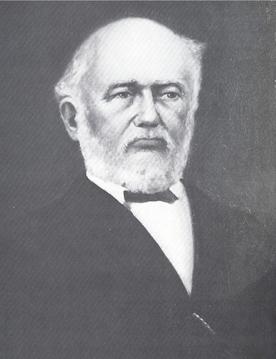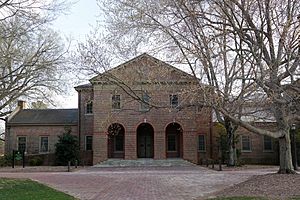Benjamin Stoddert Ewell facts for kids
Quick facts for kids
Benjamin Stoddert Ewell
|
|
|---|---|
 |
|
| 16th President of the College of William & Mary |
|
| In office 1854–1888 |
|
| Preceded by | John Johns |
| Succeeded by | Lyon Gardiner Tyler |
| Personal details | |
| Born | June 10, 1810 Washington, D.C. |
| Died | June 20, 1894 (aged 84) Williamsburg, Virginia |
| Resting place | College of William and Mary Cemetery, Williamsburg |
| Relations | Richard S. Ewell (brother) |
| Alma mater | United States Military Academy |
| Military service | |
| Allegiance | United States of America Confederate States of America |
| Branch/service | United States Army Confederate States Army |
| Years of service | 1832–36 (USA) 1861–65 (CSA) |
| Rank | |
| Commands | 32nd Virginia Infantry |
| Battles/wars | American Civil War |
Benjamin Stoddert Ewell (born June 10, 1810 – died June 20, 1894) was an American soldier, engineer, and teacher. He served in both the United States Army and the Confederate Army. He is best known for being the president of the College of William and Mary in Williamsburg, Virginia. He led the college before, during, and after the American Civil War.
Even though he didn't want Virginia to leave the Union, Ewell helped form local militias when the Civil War began in 1861. He designed and built important defenses around Williamsburg, including Fort Magruder. These defenses helped slow down Federal troops during the Peninsula Campaign in 1862. His younger brother, Richard S. Ewell, was a famous Confederate General.
Benjamin Ewell worked tirelessly to bring the College of William and Mary back to life after the war. His efforts to restore the historic school and its programs were legendary. He eventually succeeded in getting funding from both the U.S. Congress and the state of Virginia.
Contents
Who Was Benjamin Stoddert Ewell?
Benjamin Stoddert Ewell was born in Georgetown, which is part of Washington, D.C. His parents were Dr. Thomas Ewell and Elizabeth Stoddert Ewell. His grandfather was Benjamin Stoddert, who was the very first U.S. Secretary of the Navy.
His Education and Early Jobs
Ewell graduated from the U.S. Military Academy in West Point, New York, in 1832. After graduating, he stayed at West Point as a math professor until 1835. He also taught natural and experimental philosophy there until 1836.
In 1836, he left West Point to work as an assistant engineer. He helped build the Baltimore and Susquehanna Railroad. This railroad connected Baltimore, Maryland with Sunbury, Pennsylvania. He worked on the railroad until 1839.
Ewell then moved to Virginia in 1839. He became a professor of mathematics at Hampden–Sydney College. He taught there until 1846. After that, he moved to Lexington, Virginia. He taught math and military science at Washington College (now Washington and Lee University) from 1846 to 1848.
Becoming College President
In 1848, Ewell became a professor of mathematics at the College of William and Mary in Williamsburg, Virginia. He also served as acting president. He bought a farm nearby in James City County, Virginia and built a large house there. This house became known as Ewell Hall. He was officially named president of the college in 1854. He served as president until 1888, even when the college was closed during the Civil War.
Benjamin Ewell and the Civil War
In 1861, Benjamin Ewell became the captain of the college's militia. Many students joined the Confederate States Army. Because of this, the college faculty decided to close the school on May 10, 1861. The main college building, the Wren Building, was used as a barracks for Confederate soldiers. Later, it became a hospital for both Confederate and Union forces.
Even though Ewell didn't support Virginia leaving the Union, he joined the Confederate Army. He became a colonel in the Confederate Army. He helped form the 32nd Virginia Infantry for local defense.
Building Defenses in Williamsburg
In 1861 and 1862, Ewell was in charge of building the Williamsburg Line. This was a series of defensive forts across the Virginia Peninsula. It stretched from College Creek in the south to Queen's Creek in the north. They built 14 forts along this line. The most important one was Fort Magruder, located where two main roads met.
After the Battle of Williamsburg on May 5, 1862, Union soldiers occupied Williamsburg. The Brafferton building at the college was used by the Union commander. On September 9, 1862, some Union soldiers set fire to the college building. They claimed they wanted to stop Confederate snipers from hiding there. The town and college suffered a lot of damage during the Union occupation, which lasted until 1865.
After the Battle of Williamsburg, Ewell left the 32nd Virginia Infantry. He joined the staff of General Joseph E. Johnston. Later, he became an assistant to his younger brother, General Richard S. Ewell.
Bringing the College Back to Life
After the Civil War, the College of William and Mary was in ruins. Virginia's economy was also very poor. Ewell went to Washington, D.C., many times. He asked the U.S. Congress for money to repair the college. He wanted them to pay for the damage caused during the war. The U.S. government finally paid some money, but not until 1893.
In 1869, Ewell reopened the college using his own money. He became president again. He even mortgaged his family farm, meaning he used it as collateral for a loan. He lost the farm when he couldn't pay the loan back. Despite his hard work, the college had to close again in 1881 due to money problems. It did not reopen until 1888.
A famous story at the college says that every single morning during those seven years the college was closed, Benjamin Stoddert Ewell would ring the college bell. He did this so no one could ever say that William and Mary had stopped its mission to educate young people.
In 1888, the college finally reopened. The Virginia General Assembly passed a law giving $10,000 to support the college as a state teacher-training school. Once Ewell knew the college he loved would survive, he retired at age 71. Lyon Gardiner Tyler became the next president.
Benjamin Ewell stayed in Williamsburg as president emeritus until he died on June 19, 1894. He was buried in the College of William and Mary Cemetery. You can find his personal papers and college records at the Special Collections Research Center at the college.
Benjamin Ewell's Legacy
Benjamin Ewell is remembered in several ways:
- The community of Ewell, Virginia, and Ewell Station in James City County, Virginia, are named after him.
- Ewell Hall, the historic house he built on his farm, is now part of Williamsburg Memorial Park.
- A building on the campus of the College of William and Mary, also called Ewell Hall, is named for him.
- In 1987, the College of William and Mary's Student Association created an award in his honor.
Benjamin Ewell is most remembered for his amazing efforts to rebuild the College of William and Mary after the Civil War. He once told the U.S. Congress: "No institution of learning in the South lost so much by the civil war... The College... will rise with renewed vigor... to repay any benefit which Congress may bestow."



